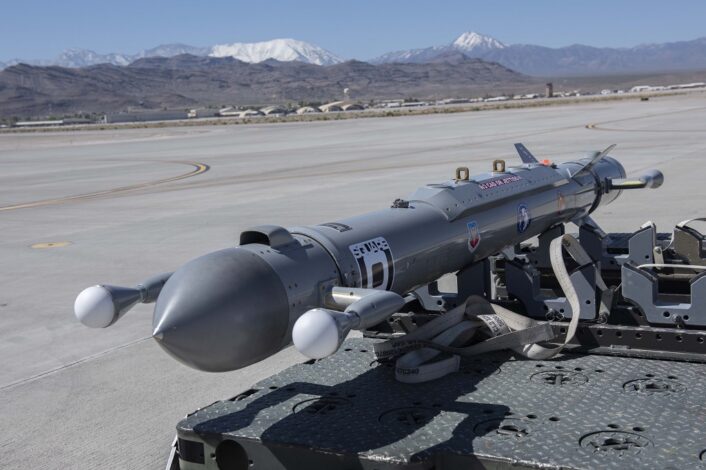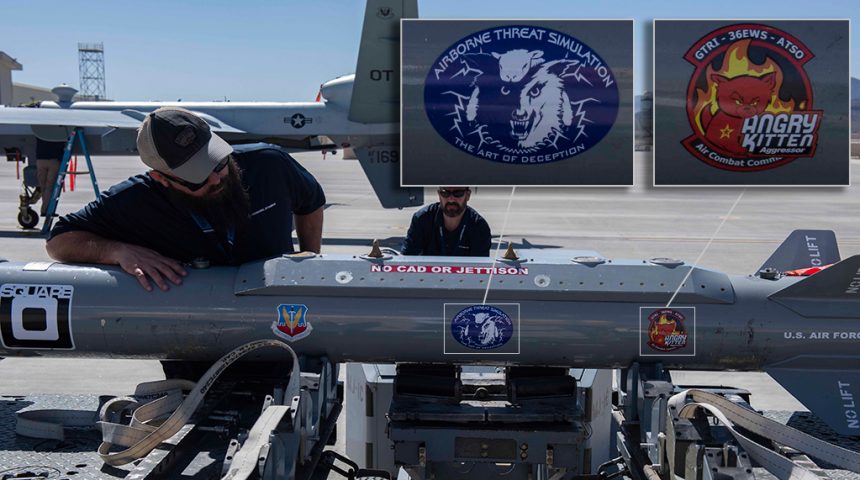The service is looking to expand the mission sets of the MQ-9, adding a new Electronic Attack capability.
In a press release published recently, the U.S. Air Force disclosed that the 556th Test and Evaluation Squadron completed in April the first round of ground and flight testing of the ALQ-167 Angry Kitten Electronic Countermeasures (ECM) pod installed on the MQ-9A Reaper at Creech Air Force Base, Nevada. The pod will add a new Electronic Attack capability to the Reaper’s arsenal against relevant ground and airborne threats.
This capability enhances survivability for the Reaper and other friendly forces, and complicates adversary planning efforts, says the Air Force. The test focused on proving the concept of conducting Electronic Attack from the MQ-9 to provide operational planners new force application options when confronting Pacing Challenge threats.
“The goal is to expand the mission sets the MQ-9 can accomplish,” said Maj. Aaron Aguilar, 556th TES assistant director of operations. “The proliferation and persistence of MQ-9s in theater allows us to fill traditional platform capability gaps that may be present. Our goal is to augment assets that already fill this role so they can focus and prioritize efforts in areas they are best suited for.”
The 556th TES is now looking to the participation in future Large Force Exercises (LFEs), such as Red Flag 23-3 and Northern Edge 2023, and integrating with the U.S. Air Force Weapons School, further developing Tactics, Techniques, and Procedures (TTPs) against complex target sets. These LFEs are ideal for testing as they are opportunity for joint, multinational and multi-domain operations designed to provide high-end, realistic war fighter training, and thus closer to the real operational scenarios.
“Electronic Attack on the MQ-9 is a compelling capability,” said Lt. Col. Michael Chmielewski, 556th TES commander. “15 hours of persistent noise integrated with a large force package will affect an adversary, require them to take some form of scalable action to honor it, and gets at the heart of strategic deterrence.”
The Angry Kitten pod started its life as a training pod about ten years ago, developed by the Georgia Tech Research Institute, simulating enemy electronic attack signals during Air Force test and training missions. Its main users are the Aggressor squadrons, which use it while flying as Red Air during LFEs against the Blue Air, adding the Electronic Warfare to the list of problems that trainees have to face.

Given the success of the pod in training and demonstrated ability to be quickly reprogrammed, last year Air Combat Command recommended four pods be converted into combat pods to provide attack capabilities against enemy radio frequency threat systems, instead of simulating them. During a two-week test, the self-defense jamming pod’s mission data file software was updated overnight to improve performance seen against threats each day.
“The hardware and software stovepipe solutions prevalent throughout the Air Force enterprise significantly impair the Air Force’s ability to quickly adapt and defeat new emerging electromagnetic systems threats,” said last year Keith Kirk, App-Enabled Rapidly Reprogrammable Electronic warfare/electromagnetic Systems program manager. “AERRES is demonstrating open hardware/software solutions that allow platforms to upgrade capability by swapping hardware modules and/or software apps to change electromagnetic systems offensive and defensive effects.”
The success of the pod is also due to the technology used by the Georgia Tech Research Institute. Angry Kitten, in fact, leverages commercial electronics and machine learning for a cognitive Electronic Warfare approach, choosing the optimal jamming technique and adapting its response based on the effectiveness against the threat, as well as responding to the adversary’s use of electronic attack techniques.
In the same press release, the Air Force also mentioned other testing activities currently ongoing to make the Reaper more relevant in future scenarios. In fact, earlier in April, the 556th TES executed a Cold Integrated Combat Turn on an MQ-9 which included simultaneous refueling and rearming of four AGM-114 Hellfire missiles. The event took less than 25 minutes, crushing the standard three-hour turn time for the RPA and only adding 4 minutes to the previously demonstrated rapid refuel procedures that did not include weapon reloading.
“The Cold Integrated Combat Turn furthers our validation efforts on the MQ-9 agile combat employment model and further maximizes the MQ-9’s relevancy across the continuum of strategic competition and the phases of combat operations in all theaters that require agile operations,” said Lt. Col. Chmielewski.









